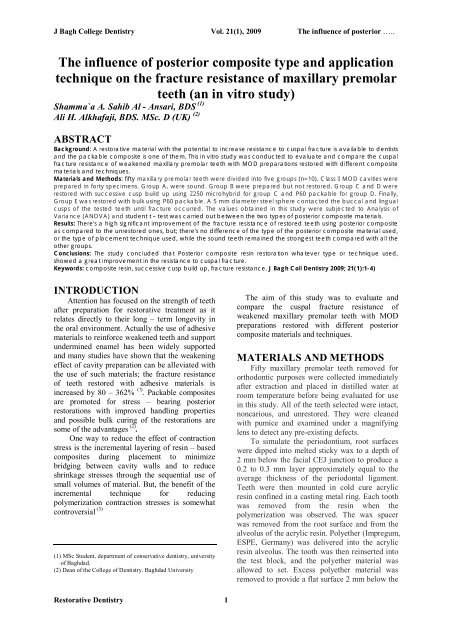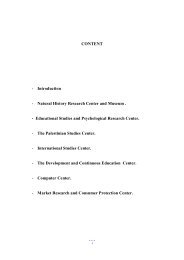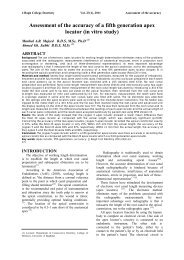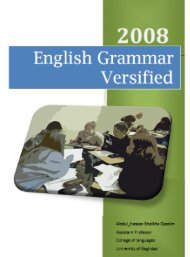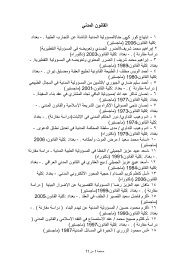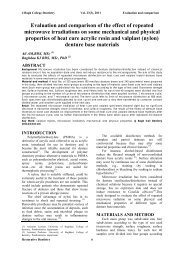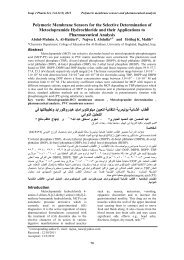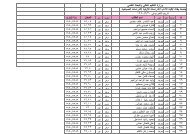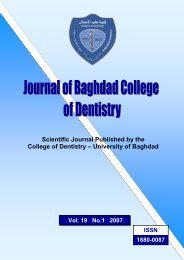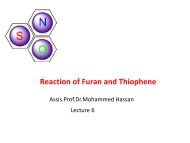Vol 21 No. 1
Vol 21 No. 1
Vol 21 No. 1
You also want an ePaper? Increase the reach of your titles
YUMPU automatically turns print PDFs into web optimized ePapers that Google loves.
J Bagh College Dentistry <strong>Vol</strong>. <strong>21</strong>(1), 2009 The influence of posterior …..<br />
The influence of posterior composite type and application<br />
technique on the fracture resistance of maxillary premolar<br />
teeth (an in vitro study)<br />
Shamma`a A. Sahib Al - Ansari, BDS (1)<br />
Ali H. Alkhafaji, BDS. MSc. D (UK) (2)<br />
ABSTRACT<br />
Background: A restorative material with the potential to increase resistance to cuspal fracture is available to dentists<br />
and the packable composite is one of them. This in vitro study was conducted to evaluate and compare the cuspal<br />
fracture resistance of weakened maxillary premolar teeth with MOD preparations restored with different composite<br />
materials and techniques.<br />
Materials and Methods: fifty maxillary premolar teeth were divided into five groups (n=10). Class II MOD cavities were<br />
prepared in forty specimens. Group A, were sound. Group B were prepared but not restored. Group C and D were<br />
restored with successive cusp build up using Z250 microhybrid for group C and P60 packable for group D. Finally,<br />
Group E was restored with bulk using P60 packable. A 5 mm diameter steel sphere contacted the buccal and lingual<br />
cusps of the tested teeth until fracture occurred. The values obtained in this study were subjected to Analysis of<br />
Variance (ANOVA) and student t – test was carried out between the two types of posterior composite materials.<br />
Results: There's a high significant improvement of the fracture resistance of restored teeth using posterior composite<br />
as compared to the unrestored ones, but; there's no difference of the type of the posterior composite material used,<br />
or the type of placement technique used, while the sound teeth remained the strongest teeth compared with all the<br />
other groups.<br />
Conclusions: The study concluded that Posterior composite resin restoration whatever type or technique used,<br />
showed a great improvement in the resistance to cuspal fracture.<br />
Keywords: composite resin, successive cusp build up, fracture resistance. J Bagh Coll Dentistry 2009; <strong>21</strong>(1):1-4)<br />
INTRODUCTION<br />
Attention has focused on the strength of teeth<br />
after preparation for restorative treatment as it<br />
relates directly to their long – term longevity in<br />
the oral environment. Actually the use of adhesive<br />
materials to reinforce weakened teeth and support<br />
undermined enamel has been widely supported<br />
and many studies have shown that the weakening<br />
effect of cavity preparation can be alleviated with<br />
the use of such materials; the fracture resistance<br />
of teeth restored with adhesive materials is<br />
increased by 80 – 362% (!) . Packable composites<br />
are promoted for stress – bearing posterior<br />
restorations with improved handling properties<br />
and possible bulk curing of the restorations are<br />
some of the advantages (2) .<br />
One way to reduce the effect of contraction<br />
stress is the incremental layering of resin – based<br />
composites during placement to minimize<br />
bridging between cavity walls and to reduce<br />
shrinkage stresses through the sequential use of<br />
small volumes of material. But, the benefit of the<br />
incremental technique for reducing<br />
polymerization contraction stresses is somewhat<br />
controversial (3)<br />
(1) MSc Student, department of conservative dentistry, university<br />
of Baghdad.<br />
(2) Dean of the College of Dentistry. Baghdad University<br />
The aim of this study was to evaluate and<br />
compare the cuspal fracture resistance of<br />
weakened maxillary premolar teeth with MOD<br />
preparations restored with different posterior<br />
composite materials and techniques.<br />
MATERIALS AND METHODS<br />
Fifty maxillary premolar teeth removed for<br />
orthodontic purposes were collected immediately<br />
after extraction and placed in distilled water at<br />
room temperature before being evaluated for use<br />
in this study. All of the teeth selected were intact,<br />
noncarious, and unrestored. They were cleaned<br />
with pumice and examined under a magnifying<br />
lens to detect any pre-existing defects.<br />
To simulate the periodontium, root surfaces<br />
were dipped into melted sticky wax to a depth of<br />
2 mm below the facial CEJ junction to produce a<br />
0.2 to 0.3 mm layer approximately equal to the<br />
average thickness of the periodontal ligament.<br />
Teeth were then mounted in cold cure acrylic<br />
resin confined in a casting metal ring. Each tooth<br />
was removed from the resin when the<br />
polymerization was observed. The wax spacer<br />
was removed from the root surface and from the<br />
alveolus of the acrylic resin. Polyether (Impregum,<br />
ESPE, Germany) was delivered into the acrylic<br />
resin alveolus. The tooth was then reinserted into<br />
the test block, and the polyether material was<br />
allowed to set. Excess polyether material was<br />
removed to provide a flat surface 2 mm below the<br />
Restorative Dentistry 1


